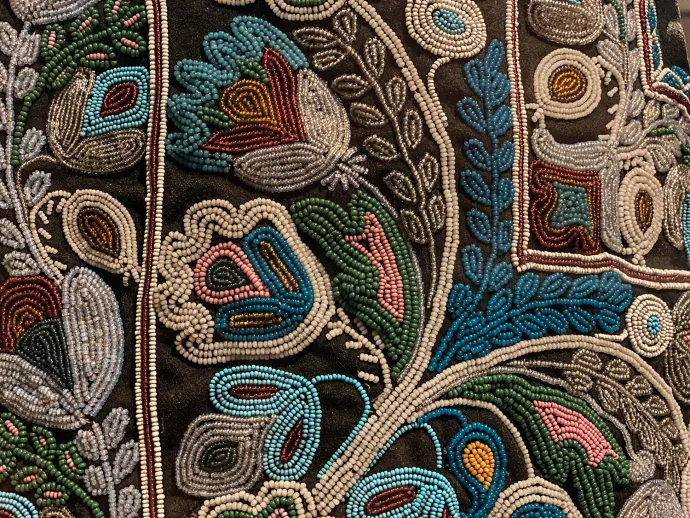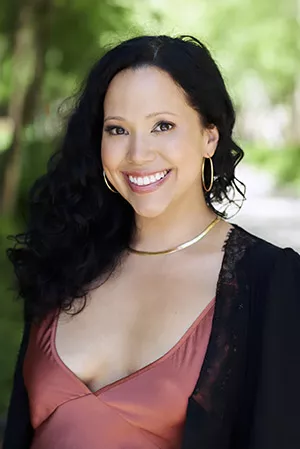
And the bead goes on

“I started out in archaeology and wondered why it was that I and so many other native friends and scholars were doing work in either anthropology or archaeology,” says Bos, an assistant professor in UTM’s Department of Historical Studies.
Bos, who is Métis from Treaty 8 territory in Northern Alberta, was studying medieval sexuality for her Master’s at Oxford University at the time.
“There is an enduring focus on us and our histories, and I just got really frustrated because it turned out there were a lot of people at Oxford studying Indigenous folks, but there were no Indigenous people doing that work there. I decided I should do that work, and do it in a better way.”
Her first research undertaking in this regard was at the Pitt Rivers Museum, which is based at Oxford and houses over 500,000 photographs, manuscripts, and objects from around the world. Bos was examining beaded panel bags and this was her first serious initiation into material culture and what has now become a central part of her research focus: tiny glass seed beads.
In the October edition of VIEW to the U podcast, Kristen talks about her research, particularly on Indigenous feminisms, with among other things, considers the past, present, and future of seed beads.
Seed beads have been used by Indigenous communities for thousands of years, and vary in size, but usually measure no more than 5 mm – or for a sense of scale, a bit smaller than a sesame seed. Bos says that seed beads tell stories, they govern lands, and they have been used as currencies in many transactions in the past.
Though Bos’s main focus is on Indigenous feminisms and seed beads, science, technology and toxicity also factor prominently into her work, and, specific to beads, how beads have often been preserved using harmful chemicals since the 1700s and how that toxicity pervades today.
“The main work I'm doing with beads is thinking about them also as earthworks,” says Bos.
“So, beads as glass, and glass as silica or sand, glass as potash or the ashes of plants, glass as limestone or the calcified remains of flora and fauna. This really ties into other Indigenous feminist scholarships, such as Métis anthropologist Zoe Todd’s work on thinking of oil petrochemicals as a kind of fossilized kin, and thinking about the kind of relationships we can build and these substances that weren't toxic before, but under settler colonialism and with certain technologies become toxic.”
Throughout her work, Bos has encountered curators and archivists who now either refuse to go into collections because of this chemical contamination or who have donned personal protective equipment while working with these materials long before the COVID-19 virus hit, and this is also something she is zeroing in on in her work.
In relation to viruses and beads, when asked about some of her favourite beaded pieces that she has come across, the work of Cree artist Ruth Cuthand is the immediate one Bos mentions: Cuthand’s “Trading Series” represents 12 viruses that originated with Europeans (such as measles, bubonic plague, small pox, etc.) and one disease, syphilis, that was brought back to Europe. Cuthand beads these viruses as they would appear under a microscope, and she continued the series up until last year, beading COVID-19. Bos has a print of this particular Cuthand creation, and it will be hanging on the wall of her office at UTM once she sets up on campus; she joined the faculty at UTM in 2020, and so she has yet to fully move in to her space in Maanjiwe nendamowinan.
As someone who has beaded since she was young, Bos does her own beadwork as well as looming when she has time, but she admits to being a bit challenged when it comes to her own artistry, preferring instead to follow patterns or templates.
Bos says that seed beads and Indigenous art more generally are having a bit of a moment right now, but she sees them as having so many facets for further study and consideration.
For a deeper dive into this topic, she has a forthcoming book, what the seed beads saw: Indigenous Feminist Disruptions of Colonial, Gendered and Environmental Violence.
“I think about beads as method, beads as a research subject, beads as witnesses, and beads figure in some of the most famous and really pervasive settler colonial narratives,” says Bos, who adds that the founding of the league of five nations treaty, the land on which UTM currently stands, was made from wampum, which are small cylindrical beads made out of various kinds of shell.
“Beads are storytelling devices and a visual reference to colonization that help to frame our history, while also representing Indigenous futures.”
Resources
- For more on Professor Bos's work visit her website.
- Kristen mentioned Indigenous artist Ruth Cuthand's seed bead work.
- As a point of entry for more information on this material, Professor Bos mentioned an article by UofT Professors Eve Tuck and Karyn Recollet: "Introduction to Native Feminist Texts."
- Kristen also mentioned the exhibit curated by Lisa Myers: "Beads, they're sewn so tight."
- Kristen mentioned the following books as recommended reading: A Third University is Possible (la paperson), Wayward Lives, Beautiful Experiments (Saidiya Hartman), and Theory (Dionne Brand).
Lastly, the Reservation Dogs series by Sterlin Harjo and Taika Waititi is the TV show she was enjoying lately. Highly recommend!
